Freight Bogies
A “truck”, or in British terminology a “bogie”, is the wheel assembly on a train car, consisting of the wheels, axles, bolsters and associated hardware. JR Freight uses a number of standard types of trucks. The Japanese term (“形台車” or “Katachi daisha”) is translated (by Google anyway) as “Dolly Form”. This page provides a partial list of those used on Japanese trains. Because of the sparsity of information, and the wide use of freight cars of the same design under both JNR and JRF, I have not limited this page to those found in the Tōkyō region.
Information on this page largely comes from the wikipedia pages cited at the bottom of the page, machine-translated. As such it is doubly-suspicious and errors of detail are probable. The general picture it provides is likely correct.
Technology
The truck assembly used for rail cars is designed to spread the weight of the car over more surface area (ties) and to absorb shocks from rail joints and other irregularities, as well as allowing wheels to pivot on curves, and to change position due to uneven track in ways that body-mounted wheelsets cannot. They are typically found on Japanese passenger cars and on newer freight cars. Many older Japanese freight cars (and a few still in current use) use body-mounted wheelsets instead, due to low-speed operation and lighter capacity requirements.
Trucks contain two or more “wheelsets”: an axel with two wheels. The end of each axel fits into a bearing, that allows it to turn, and these are held in place by sideframes. The sideframes connect to a “bolster” via some kind of shock-absorbing mechanism (typically coil springs or leaf springs) and dampers may be attached to reduce vibration. The car body sits atop the bolster, which can pivot beneath it. Typically there is no attachment, and a car can simply be lifted off the truck for maintenance (or the car held on jacks and the truck lowered, which is the usual method used in service facilities).
There are two kinds of bearings: friction and roller bearings. The Japanese phrase for “roller bearing” is “コロ軸受” (“koro jikuuke”). The phase “平軸受” (“hirajikuuke”) or “flat bearing” appears to mean a friction bearing (roller bearings were introduced in the 1920’s, but didn’t find wide use on U.S. freight until the 1950’s or 1960’s; friction bearings were an older design that needed frequent lubrication and had a tendency to overheat, and were outlawed in the U.S. after 1974). It’s unclear if any “flat bearings” remain in use in Japan today, although it appears that they started making the transition to roller-bearing freight cars around 1970.
Freight Trucks
The following models are used on freight cars. The TR41 friction-bearing truck is the origin of most of the normal-speed (65 kph to 75 kph) designs, and the TR63 (which soon became a roller-bearing design if it wasn’t from the beginning) was the origin of most of the express (85 kph and above) designs.
TR20
The TR20 was perhaps an “archbar” truck design, rather than a more modern Bettendorf. The TOKI 15000 (gondola) article, in a description of the wartime TO 10, refers to it as an “achiba” design, likely a phonetic approximation of “archbar”. It would appear that this model was in use as of 1943 (and likely earlier) and the last was phased out in 1970. Archbar trucks used frames made of bolted steel strips rather than cast sideframes, which would have been economical during wartime steel shortages, but had severe load limits.
The TR20 design was used on early models (from 1947) of the TAKI 3000 (later models apparently used the TR41).
TR41, TR41C, TR41D, TR41DS, TR41E, TR41ES, TR41F, TR41G
This is a fairly basic truck, dating from the JNR era (pre-1987) but apparently still in use in some form. The original design was a friction-bearing, leaf-spring Bettendorf design. All references I have seen give a top speed for cars equipped with this truck of 75 kph. It seems likely that the standard version was rated for 12 tons/axle, with variants rater for 13 tons/axle being produced in later years and designated with a -13 suffix.
Variants:
TR41 - likely dating from c. 1950, this appears to have been a 12 ton/axle design
TR41A - Unclear what differentiates this form
TR41C - in use by 1958, leaf springs, top speed of 75 kph
TR41D - In use c. 1965, coil springs
TR41DS - unclear what this denoted, but there were at least two versions of it (TR41DS-12 and TR41DS-13)
TR41E-12 - Unclear how this differed from the TR41E-13.
TR41E-13 - This model had a damper, as well as coil springs
TR41ES-13 - Unclear how this differed from the TR41E-13. It may have been a prototype.
TR41F - details unknown
TR41G - details unknown, in use before 1973 with “improved detail”, 75 kph
The style of the axle boxes make these appear to be friction bearings and this agrees with various statements about them in wikipedia articles, although it’s possible they were converted to roller bearings at some point (the axle bearing covers appear to be fixed in place rather than openable in the picture below). The Japanese wikipedia page for Bettendorf Trucks says that the TR41 uses the Bettendorf design, originally developed in the U.S. in 1910.
Most modern Japanese freight trucks seem to trace their ancestry back to the TR41. Although I haven’t found an origin date, the passenger TR40 truck was developed c. 1950, and although that is a very different design, that suggests that the TR41 is an early-1950’s design.
The TR41C was a leaf-spring design, and the TR41D was a coil-spring design, so this likely marks the transition point between the two types of spring as being around 1965. Coil springs of one form or another appear to have been used on all later trucks. The TR41C had a top speed of 75 kph.
I’ve seen one reference to a TR41C used on a HOKI 6600 (which was apparently a derivative of the 2200 designed for carrying malt for Sapporo Brewery). Images on this car seen online (not identifying trucks) show a TR41-style truck, with some appearing to have openable bearing covers. The TR41C was also used on the earlier models of the HOKI 5700 produced from 1965, but late production models used the TR41G for a short time and then later units used the TR41E-13.
The TR41C and TR41D were used on TAKI 4100 liquified ammonia tank cars dating from 1963, with the TR41D apparently being introduced in Showa 40 (1965). The TR41C was also initially used on the TAKI 5450-series liquid chlorine cars, with TR41D introduced later, and eventually the TR211B and TR216B replaced these to transition the cars to roller bearings.
The TR41C, TR41D, TR41E, TR41F and TR41G were used on TAKI 1900 tank cars produced from 1964. Other or later models of these cars used TR209 (possibly also TR209B), TR225, and TR213C trucks.
The TAKI 5470 sulfuric acid tank car was introduced in 1966 with the TR41C, but later models used a TR41E-13, which differed in having a “spring coil double pillow” (which may simply mean dual coil springs as compared to the TR41C leaf-spring design) and an oil damper.
The TAKI 7750 potassium hydroxide tank car used TR41C trunks initially, but later used the TR41DS, and TR41E and later TR213C or TR225 roller-bearing trucks.
The TAKI 46000 sulfuric acid tank car (produced c. 1985), a variant of the TAKI 45000, used TR41DS-12 and later TR41DS-13 trucks, as well as TR41E-12 and later TR41E-13 trucks. It would appear the -13 models had a higher load rating, and the number may be a tons/axle rating.
See also the description of the TR210, which was a derivative.
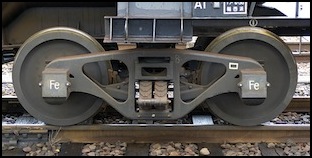
TR41 (type unknown) on a TAKI 4200 tank car
Photographer: 出々 吾壱 (2007)
Note: this photo is described as a TR41C in the TAKI 9900 article. However, see the TR209 entry.
TR63, TR63A, TR63B, TR63CF, TR63DF, TR63F, TR63G
This was an improved version of the TR91, used on the initial production models of the KOKI 5000-series container flats, and was capable of operation at up to 85 kph. The TR63A was introduced in 1960 with the and 5500-series container flats and incorporated an improved brake.
Variants:
TR63 - c. 1959, 85 kph
TR63A - c. 1960, improved brake
TR63B - by 1963, coil springs and dampers
TR63CF - c. 1970, a high-speed variant
TR63DF - Unclear, but related to the TR63F
TR63F - Used a “resin” brake pad, retrofit to earlier models
TR63G c. 1986 heavy-duty variant used in 75 kph operation
The TR63B was used on the WAKI 5000 express boxcar (built 1965) and later, c. 1967 for tests against the TR211A that led to the development of the TR216A. This was a roller-bearing, coil spring design equipped with oil dampers and capable of 85 kph operation.
The TR63CF was used on the KUMU 80000, which was rated for 100 kph operation. It appears that this also differed from the earlier TR63C in using the same brake design introduced on the TR222 in 1970.
The TR63F (and TR63DF, the difference is unclear) was a later remodeling (or redesign) used to replace older TR63 trucks on existing cars. This used a modified brake with a “resin” brakepad or similar, for improved stopping power. The TR63F was also used on the TIKI 6000-series flatcar.
The TR63G appears to be a heavy-duty variant of the TR63CF used when some of the KU 5000-series cars were converted to SEKI 8000-series coal cars in 1986 (or perhaps the trucks off the KUs were rebuilt into the TR63G form and used on new SEKI 8000s). The SEKI 8000 was rated for 75 kph operation.
The KU 5000 used a TR63C on models produced from 1966 until 1970, and after that a TR222. TR63CF and TR63G were used on later models of the KU 5000 (or perhaps this was an update for the earlier models applied later).
Problems with the brake design of the TR63 series led to the development of the TR211 (which may have been influenced by the TR220 design).
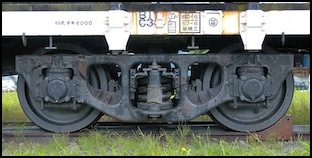
TR63F on a TIKI 6000 at Otaru University Museum
Photographer: 出々 吾壱 (2007)
TR78
This truck was used on the TAKI 50000 gasoline tank car (produced c. 1960). This appears to have been a friction-bearing design with coil springs and a damper, and appears to have been a three-axle design. It may have only been used on these cars, the last of which was scrapped in 1993.
TR79
The TR79 was used on the TAKI 64000 petroleum tank car, built in 1969. This was a 14 ton-per-axle roller-bearing design, and appears to have been a three-axle design. It may have only been used on these cars, the last of which was scrapped in 1993. This truck appears to have been a derivative of the TR78 design.
TR91
This truck design was used initially (from 1959) on the prototype KOKI 5500-series container flats, and was capable of operation at up to 85 kph.
TR92
This truck design was a prototype, later standardized as the TR78.
TR95
This appears to have been a prototype design for the TR207.
TR203, TR203A
This was an air-spring design with a rubber axle block used on KOKIFU 50000-series and 10000-series container flat cars equipped with a conductor’s office. It appears to have been developed for the KOKI 10000-series container flat cars introduced in 1966, however this may only have been for use on the KOKIFU 10000-series cars (equipped with a conductor’s office). The TR203 was rated for 100 kph operation. The TR203A was developed in 1969 with modifications to the brake assembly and to permit a lower deck height, and used on the 19000 sub-series of KOKI 10000.
It appears that this was a late addition, c. 1979, to the 50000-series. This had a lower maximum permissible load there (54 tons/car), so one of the container mounting points on the cars was removed when they were added. If I read the page correctly, when these cars were converted to ordinary KOKI’s (without the office) in 1985, the standard TR223 truck replaced the TR203.
The TR203 was apparently also used on the NAHA 29000-series passenger cars produced for a barbecue train by JR Hokkaido in 2000. This was likely a recycling of older trucks as it appears these cars were based on the KOKI 10000.
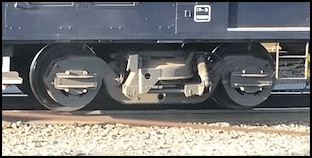
TR203 on NAHA 29002
Photographer: 出々 吾壱 (2006)
TR207, TR207B
The TR207 was developed c. 1966 for use on the HOKI 2200 hopper cars used to transport grain and other “agricultural powder” commodities, rated for 85 kph use. This was a friction-bearing design, later modified to use TR211-style roller bearings and all cars were upgraded. It is possible that the TR211 is actually a TR207 modified with roller bearings (see the TR211 entry).
The TR207B was developed for use on the TAKI 18600-series liquified ammonia tank car in 1970. This was replaced by the TR216B. The implication of the article is that this was not a roller-bearing design.
TR209
The TR209 was used on some models of the TAKI 1900 tank car and early models of the TOKI 25000 gondola car produced from 1967. It was apparently a roller-bearing derivative of the TR41. Some comments suggest that this designation was used for a TR41C (leaf-spring) truck converted to roller bearings but this doesn’t appear to be the case since it was used for new construction also. However, the TR41 photo above may actually be of a TR209 if that were true.
TR210
The TR210 was the original truck used on the TAKI 43000, produced in 1967. It was later replaced by the TR214B. This appears to have been a friction bearing design, with a 14-ton-per-axle load limit. This was a derivative of the TR41 that added coil springs and a damper. The TR214 was derived from the TR210. Top speed is unclear, but may have been 75 kph.
TR211, TR211A, TR211B
The TR211 was used on HOKI hopper cars and TOKI 80000 gondola cars. The TR211A was developed from this c. 1970 for testing on KOKI 5500-series container flat cars that led to the development of the TR221A. It apparently differs from the original in the spring or damper design.
I found some text from a Japanese blog (entry no longer online) that suggested the TR211 was a TR207 modified with a roller bearing, at least on the HOKI 2200, and the HOKI 2200 article could be read as supporting this, but it’s not clear, and other articles seem to define them as two separate trucks. The WAKI 5000 article says that the TR211 was developed due to problems with the TR63 truck’s brakes and used as a replacement on at least some cars originally equipped with those.
The TR211B was used as a replacement on TAKI 18600-series liquified ammonia tank cars and TAKI 5450-series liquid chlorine cars. These used roller bearings and a sealed oil damper.
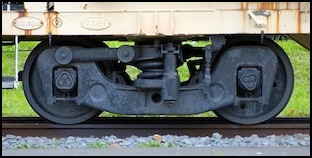
TR211A (per photographer) on a HOKI 2200 hopper car at Otaru University Museum
Photographer: 出々 吾壱 (2007)
TR213B, TR213C
The TR213B-1 was used in late-production (c. 1976) versions of the TOKI 25000 gondola car. This is described as equipped with coil springs. This model truck was also used on the TIKI 7000 flat car, produced in 1975.
The TR213C may have been used on the TAKI 7750 tank car as a roller-bearing conversion from earlier TR41C, TR41DS and/or TR41E trucks. Or it may simply be a precursor to the TR225 used on them.
TR214, TR214B
The TR214 appears to be a derivative of the TR210. The TR214B was used on the TAKI 40000 and 43000 as an upgrade or in later production (unclear). This was a “sealed, roller-bearing” design with a 15-ton-per-axle load limit and a top speed of 75 kph.
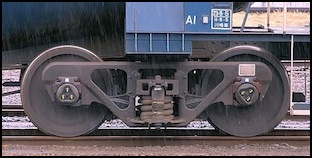
TR214B on TAKI 43000
Photographer: 出々 吾壱 (2007)
TR216, TR216A, TR216A-2, TR216B
The TR216 was a derivative of the TR211 used c. 1968 on the RESA 5000-series express refrigerated cars (rated for 100 kph use, although perhaps I’m inferring too much from the text and this was really 85 kph), and may have been used on the KOKI 50000-series container flat cars or earlier KOKI-5500 series container flat cars (the information is ambiguous).
The TR216A appears to be a derivative, based on tests carried out c. 1967 - 1970. The TR216A design was adopted in 1970 for use on “late type” (8555-8834) KOKI 5500-series container flat cars. This appears to have still been an 85-kph design, however it was modified into the TR216A-2 for 95-kph use and existing cars were retrofitted with these from 1988-1990 (there may have been some earlier 95-kph use from 1985 on the previous model, but this isn’t clear). It was also used on some WAKI 6500-series express boxcars. It apparently used a “diagonal” damper and some kind of “resin” brake with more friction for added stopping power.
The TR216B was a derivative of the TR207B used on liquified ammonia tank cars (TAKI 18600-series). The implication of one article is that this was not a roller-bearing design, however the TAKI 5450 article seems to state that it is (and that seems more likely).

TR216B on TAKI 18600
Photographer: まも (MaMo, 2007)
TR221
This design was used on at least some 5500-series KOKI container flats and KU 5000 series auto-transporter flats built between 1970 and 1973.
TR222
The TR222 was an updated TR221 with the cast-iron brake shoes replaced with a composite brake shoe. It was used on the KU 5000 after 1973.
TR223, TR223A, TR223C, TR223F, TR223G
The TR223 was originally used on the KOKI 50000-series container flat cars (I think) developed in 1970 for 95-kph operation. It was a derivative of the TR216 KOKI 5500-series container flat cars. A TR223A variant with air springs produced for the KOKIFU 50000-series container flat cars with a conductor’s office. There’s a comment on the wikipedia page I’m not sure I’m reading correctly which may imply the TR223A was a short-lived design, and was replaced by the TR203 (although it could be the other way around).
The TR223C is a roller-bearing truck used on the 50000-series KOKI container flat car, which was developed in 1971 for operation at speeds up to 95 kph. The design is based on the TR221 used on later-model 5500 KOKI cars (it’s unclear if this was a different design from the TR223 or just incorporated improvements from the TR221).
The KOKI 50000 wikipedia page says that the TR223C was introduced in 1988 on the “super liner” 350000-series cars for use at 110 kph. The TR223F was developed in 1993 as a replacement/upgrade of earlier trucks used on these cars, to address a problem with cracks in the truck frame. The TR223G was adopted in 2001 with changes to reduce vibration (which had been responsible for loads shifting at high speed).
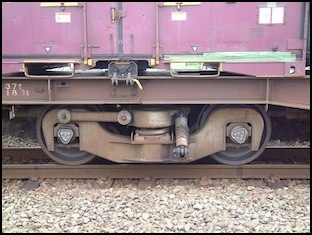
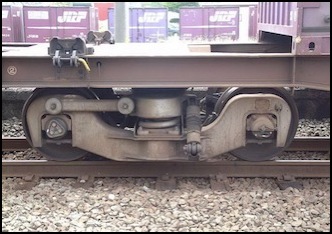
TR223F (left) and TR223G (right)
Photographer (both): Chatama (2006)
TR225
The TR209 was used on some models of the TAKI 1900 tank car. It was apparently a roller-bearing derivative of the TR41. There is also a reference to it on the TAKI 7750 article, which may be saying it was a derivative of the TR213C (or it may be saying both types were used on those cars).
The TAKI 38000 article describes it as a roller-bearing derivative of the TR41 (but essentially all freight trucks are derivatives of that model a few generations back) using coil springs, a damper, and with a 12 ton per axle rating, with a top speed of 75 kph.
TR228
The TR228 is based on the TR225.
FT1, FT1A
This is a roller-bearing design based on the TR223 model used on the 50000-series KOKI, this model is used on the KOKI 105 (and possibly earlier models). The designation suggests that this was the first truck developed under JR Freight (meaning after 1987) for freight use. There’s an implication in the description of the FT21 that the FT1 was limited to 75 kph.
An FT1-1 variant was used on the WAKI 1000, which was designed for 110 kph, but in actual practice was limited to 95 kph.
An FT1A was produced for the WA 100 Dual Mode Trailer train. This was a truck assembly with a brake wheel and attachment points where a semi-trailer could be connected. The FT1A could operate at speeds up to 110 kph.

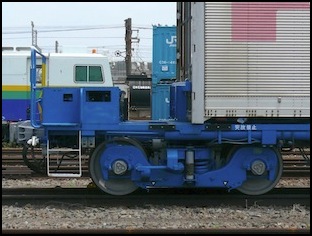
FT1 (left) and FT1A (right)
Photographer: Chatama (2006) and まも (Mamo, 2008)
FT2
This truck was introduced with the KOKI 106 series, and uses a chevron-shaped rubber damper (if I’m reading the translation correctly).
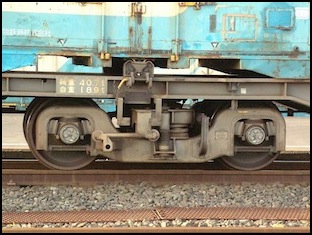
FT2
Photographer: Chatama (2006)
FT21
This is a derivative of the FT1 developed for the TAKI 1000 (produced from 1993), with smaller wheels, a lower ride-height, axle loading of 15 tons and a top speed of 95 kph.
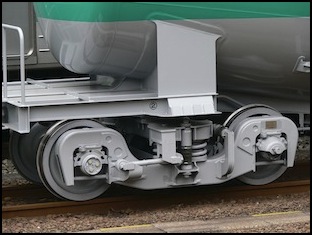
FT21
Photographer: Chabata_k (2006)
FT23
This is a derivative of the FT21. Used on TAKI 1100 tank cars produced from 1997. It apparently differs only in the spring design. The FT23A is used on TAKI 1200 tank cars used for “roasted zinc”, produced from 2010, with a different brake and some structural changes.
References
Japanese Wikipedia list of freight car types.
Bettendorf Trucks (Japanese Wikipedia)
HOKI 2200 (Japanese Wikipedia)
KOKI 5500 (Japanese Wikipedia)
HOKI 5700 (Japanese Wikipedia)
KOKI 5500 (Japanese Wikipedia) - also describes KOKI 5000
KOKI 10000 (Japanese Wikipedia)
KOKI 50000 (Japanese Wikipedia)
KU 5000 (Japanese Wikipedia)
NAHA 29000 (Japanese Wikipedia)
RESA 5000 (Japanese Wikipedia)
SEKI 8000 (Japanese Wikipedia)
TAKI 1000 (Japanese Wikipedia)
TAKI 1100 (Japanese Wikipedia)
TAKI 1200 (Japanese Wikipedia)
TAKI 1900 (Japanese Wikipedia)
TAKI 3000 (Japanese Wikipedia)
TAKI 5450 (Japanese Wikipedia)
TAKI 5470 (Japanese Wikipedia)
TAKI 6900 (Japanese Wikipedia) - detailed info on TR41C/TR41D
TAKI 7750 (Japanese Wikipedia)
TAKI 9900 (Japanese Wikipedia)
TAKI 18600 (Japanese Wikipedia)
TAKI 35000 (Japanese Wikipedia) - includes description of 45000
TAKI 38000 (Japanese Wikipedia)
TAKI 40000 (Japanese Wikipedia)
TAKI 46000 (Japanese Wikipedia)
TAKI 50000 (Japanese Wikipedia)
TAKI 64000 (Japanese Wikipedia)
TIKI 6000 (Japanese Wikipedia)
TIKI 7000 (Japanese Wikipedia)
TOKI 15000 (Japanese Wikipedia) - contains info about TR10 in the TO 10 section
TOKI 25000 (Japanese Wikipedia)
WAKI 1000 (Japanese Wikipedia)
WAKI 5000 (Japanese Wikipedia) - includes WAKI 6500 and info on TR63 redesign




